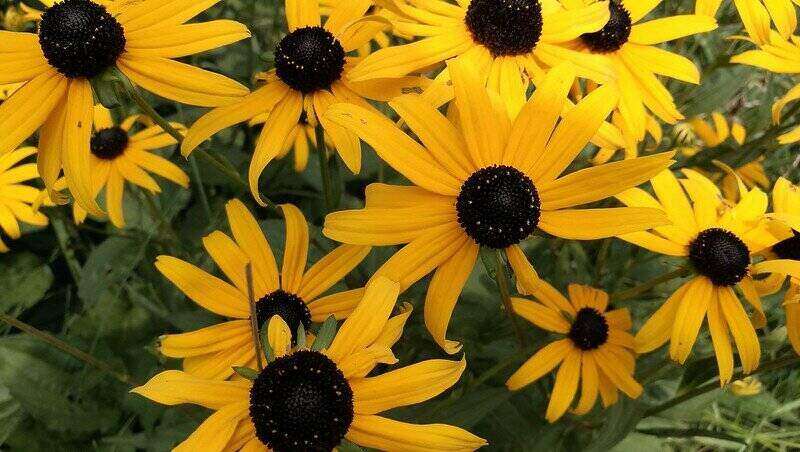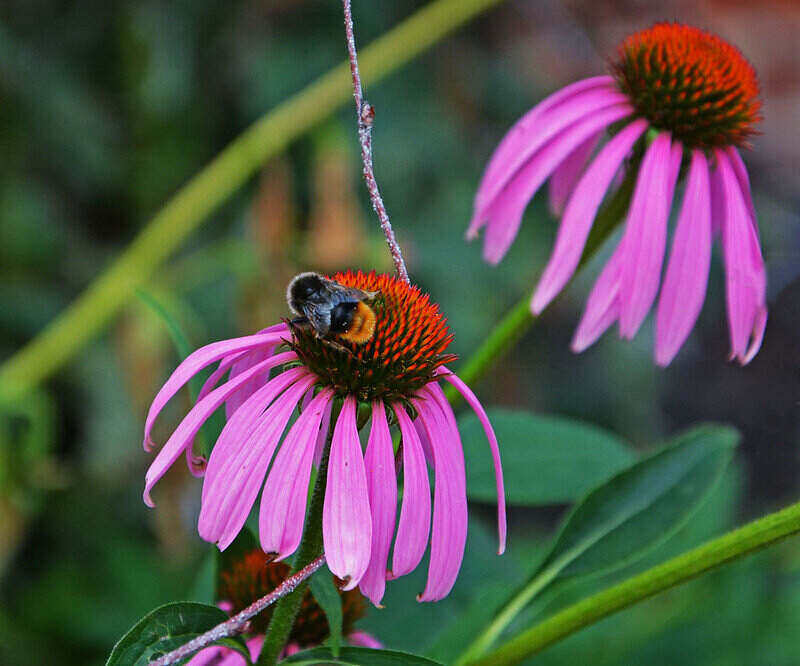
Toledo’s native plants get a big green thumbs up from Lake Erie. From black-eyed Susans to swamp milkweed, native plants require little to no chemicals to survive (unlike non-native plants). When you grow native plants instead of non-natives, fewer chemicals pollute Toledo-area waters.
What is it about native plants that make them so eco-friendly? Which plants are native to the Glass City? Our guide to the best native plants for Toledo has got you covered.
- 9 best native plants for Toledo
- 1. Black-eyed Susan (Rudbeckia hirta)
- 2. Blue-stemmed goldenrod (Solidago caesia)
- 3. Butterfly weed (Asclepias tuberosa)
- 4. Buttonbush (Cephalanthus occidentalis)
- 5. Cardinal flower (Lobelia cardinalis)
- 6. Foxglove beardtongue (Penstemon digitalis)
- 7. New England aster (Symphyotrichum novae-angliae)
- 8. Purple coneflower (Echinacea purpurea)
- 9. Swamp milkweed (Asclepias incarnata)
- Why grow native plants in Toledo?
- What are the benefits of native plants?
- How to find more native plants
- Hire a pro for easy lawn care
9 best native plants for Toledo
1. Black-eyed Susan (Rudbeckia hirta)

Add a dash of sunshine to your Toledo landscape with the black-eyed Susan. Its bright yellow petals, daisy-like appearance, and upright stem make it the perfect eye-catcher in a quaint cottage garden or meadow garden.
The black-eyed Susan may be a biennial or short-lived perennial, but that doesn’t mean you’ll need to replant every two years. The native wildflower will drop new seeds after blooming. Remove spent flower heads if you don’t want the plant to self-seed. Expect blooms June through October and its nectar to attract butterflies and bees.
The yellow flower is excellent for beginning green thumbs. It can tolerate neglect, heat, and drought, so don’t sweat it if you miss a watering or two. Just remember that the black-eyed Susan prefers well-drained, moist, organically rich soils and full sun.
- Plant type: Flower
- Hardiness zones: 3-9 (varies by species)
- Sun: Full sun
- Water needs: Medium
- Soil: Clay, sand, loam, acidic, moist, well-drained
- Duration: Biennial or short-lived perennial
- Mature height: 1-3 feet
2. Blue-stemmed goldenrod (Solidago caesia)

Building a butterfly garden? The blue-stemmed goldenrod will make a beautiful addition. It has elegant, arching leaves and features hundreds of tiny, yellow flowers clustering up and down the greenish-purple stems. It blooms summer through early fall and is attractive to bees and butterflies.
The perennial grows up to 3 feet tall and isn’t an aggressive spreader, unlike other goldenrod species and hybrids.
But wait, doesn’t blue-stemmed goldenrod cause hay fever? You’re likely thinking of ragweed, which looks similar to blue-stemmed goldenrod.
- Plant type: Flower
- Hardiness zones: 4-8
- Sun: Full sun, partial shade
- Water needs: Medium
- Soil: Can tolerate a variety of soil types. Must have good drainage.
- Duration: Perennial
- Mature height: 1-3 feet
3. Butterfly weed (Asclepias tuberosa)

Compliment your purple flowers with butterfly weed’s orange blooms. The milkweed shows off bright, flat-topped flower clusters sitting atop hairy stems with narrow leaves. The dark green foliage provides a striking backdrop, too.
Butterfly weed grows easily from seed, but don’t wait on the edge of your seat. The plant can take two to three years to develop and produce flowers in summer. Keep in mind that the milkweed doesn’t transplant well, so make sure to plant the seed in a spot you love.
And, of course, you can’t have a butterfly garden without butterfly weed. The native plant provides shelter and food for the monarch caterpillar.
Don’t have the greatest soil? Never fear! Butterfly weed is drought tolerant, moderately salt-tolerant, and performs well in poor, dry soils.
- Plant type: Flower
- Hardiness zones: 3-9
- Sun: Full sun
- Water needs: Low
- Soil: Performs well in poor, dry soil
- Duration: Perennial
- Mature height: 1-2 feet

Adorn your pond, water garden, or bog garden with the buttonbush shrub. Its balls of white flowers, coupled with protruding styles, resemble adorable pincushions.
Not only does the shrub grow well in wet areas, but it plays a vital role in the ecosystem, too. Shorebirds, ducks, and other water birds love to snack on the seeds. And butterflies, bees, and hummingbirds flock to the flower globes.
Flower heads mature into hard, reddish-brown, spherical fruits in autumn and last throughout the winter.
- Plant type: Shrub
- Hardiness zones: 5-9
- Sun: Full sun to partial shade
- Water needs: High
- Soil: Moist to wet soils with high organic matter. Sand, loam, or clay.
- Duration: Perennial
- Mature height: Usually grows 6-12 feet tall and 5-8 feet wide
5. Cardinal flower (Lobelia cardinalis)

Turn your Toledo landscape into a dramatic masterpiece with the cardinal flower. Each brilliant red flower has three lower petals and two upper petals, giving the blooms a spiky appearance. Reaching up to 6 feet tall, the plant mimics fiery flames in the landscape later summer through fall.
The cardinal flower loves moist, wet soils, making it the perfect addition to your water garden or rain garden. It doesn’t tolerate dry soils, so pay close attention to the planting bed during dry weather.
The plant’s tubular flowers depend on hummingbirds for pollination. If you need to invite this pollinator to your landscape, consider hanging hummingbird feeders filled with sugar water.
- Plant type: Flower
- Hardiness zones: 3-9
- Sun: Full sun, partial shade, full shade
- Water needs: Medium to high
- Soil: Sand, loam, clay, limestone-based
- Duration: Perennial
- Mature height: 1-6 feet
6. Foxglove beardtongue (Penstemon digitalis)

If you need to restore an area of your landscape, consider growing foxglove beardtongue. It naturalizes well, and its bell-shaped, tubular, white flowers are a sight for sore eyes May through July. The flowers rise above a stiff stem and clumping, dark green foliage.
Foxglove beardtongue is resistant to deer and tolerates dry soils and clay soils. Its drought tolerance makes it a perfect flower for your rock garden. It also will perform well in a butterfly garden.
Curious about the name? It’s called beardtongue because of the sterile stamen’s tufts of tiny hairs.
- Plant type: Flower
- Hardiness zones: 3-8
- Sun: Full sun
- Water needs: Low to medium
- Soil: Loam, sand. Moist to dry. Prefers well-drained soils. Can tolerate clay.
- Duration: Perennial
- Mature height: 2-5 feet
7. New England aster (Symphyotrichum novae-angliae)

Give your neighboring butterflies and bees something to celebrate with the New England aster. The bright, pink-purple flowers are dotted with orange-yellow centers and look so inviting to pick (and pollinate!). Just don’t be surprised by its fuzzy stem and leaves.
Get the most out of your New England aster’s stunning colors by growing it in the masses. Not only will grouping the flowers be a treat for your eyes, but pollinators will spot the purple plant more quickly, too.
The New England aster occurs naturally in moist prairies, thickets, stream banks, and meadows late summer through fall.
- Plant type: Flower
- Hardiness zones: 4-8
- Sun: Full sun, partial shade
- Water needs: Medium
- Soil: Sandy, loam, clay
- Duration: Perennial
- Mature height: 3-6 feet
8. Purple coneflower (Echinacea purpurea)

You might recognize this native plant from a tea box in your kitchen. Purple coneflower is valued for its potential health benefits and makes a beautiful plant for your native landscape April through September.
Its drooping, lavender petals are attached to a domed, spiny, purplish-brown center that bobs atop a long, stiff stem. If you think the spiny dome looks like a tiny hedgehog, you’re not wrong. The flower’s genus name is from the Greek word echinos, meaning “hedgehog.”
- Plant type: Flower
- Hardiness zones: 3-8
- Sun: Full sun, partial shade
- Water needs: Medium
- Soil: Sandy
- Duration: Perennial
- Mature height: 2-5 feet
9. Swamp milkweed (Asclepias incarnata)

Have you struggled to find a plant that will thrive in your landscape’s moist areas? Swamp milkweed loves rich, wet, muddy soils (it’s in the name, after all). Why not turn that muddy spot into a riveting bog garden with the help of swamp milkweed?
The native plant boasts charming, deep pink flower clusters summer through fall and is one of the few ornamentals that thrives in muddy clay soils. It’s the larval host of monarch and queen butterflies, which means it will be an excellent fit for your butterfly garden, too.
Similar to butterfly weed, swamp milkweed’s long taproot makes transplanting difficult.
- Plant type: Flower
- Hardiness zones: 3-6
- Sun: Full sun
- Water needs: High
- Soil: Clay, high organic matter
- Duration: Perennial
- Mature height: 3-5 feet
Why grow native plants in Toledo?
There are many benefits to growing native plants, especially here in Toledo. Non-native plants often require high levels of fertilizer, pesticides, and fungicides to survive. On the other hand, native plants need little to no chemical assistance.
Excess fertilizers, pesticides, and fungicides are often washed away by rainwater runoff and drained into local water systems. These chemicals contain high levels of nitrogen and phosphorus, which result in algal blooms in local bodies of water.
An algal bloom in Lake Erie caused Toledo’s 2014 drinking water crisis. By growing native plants, you can help minimize the lake’s exposure to these chemicals.
What are the benefits of native plants?
- Native plants help save water. Thanks to their deep roots, you don’t need to water native plants as often as non-native plants.
- Native plant roots help minimize erosion and rainwater runoff.
- Native plants have evolved and adapted to the local environment, which means they exist naturally in the area without human intervention. As a result, they’ve adapted to the soil’s fertility levels and have developed resistance against local pests and diseases.
- Native plants are low-maintenance.
- Native plants increase biodiversity, attract local pollinators, and play a vital role in the ecosystem.
- Native plants are rarely invasive.
- Native plants help you save money in the long run (you won’t be spending so much on maintenance).
How to find more native plants
If you’re interested in finding more native plants for your Toledo landscape, check out these resources:
- Toledo-Lucas County Rain Garden Initiative
- Search for native plants specific to your zip code with the NWF Native Plant Finder
- Wild Ones Oak Openings Region Chapter
- Land to Lake’s native plant guide for Northwest Ohio
And don’t forget to visit local native plant sales.
Hire a pro for easy lawn care
Growing a native garden isn’t the only way to create an eco-friendly landscape design. Another way you can reduce your chemical use is by encouraging a healthy lawn. The healthier your yard, then the fewer fertilizers, pesticides, herbicides, and fungicides you’ll need to apply.
But keeping your lawn well-maintained isn’t easy. Hire a local lawn care professional who can take the job off your hands and give your lawn expert care. From mowing the grass to aerating the soil, a lawn care pro will boost your lawn’s health while you shop for Toledo’s best native plants.
Main Photo Credit: C Watts | Flickr | CC BY 2.0